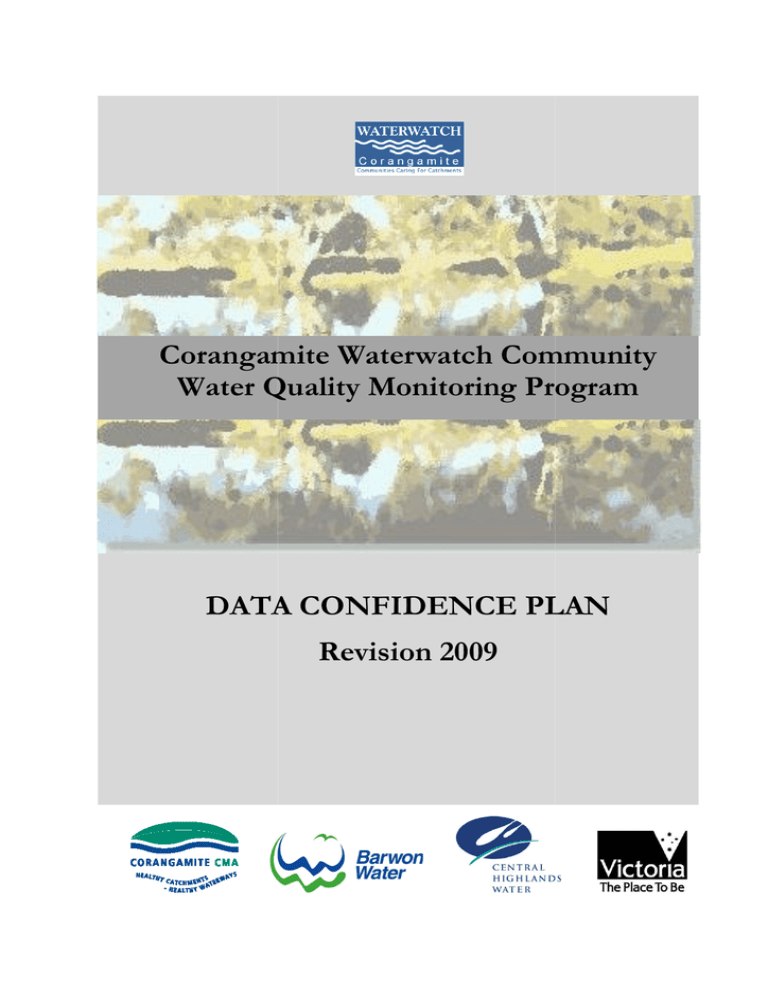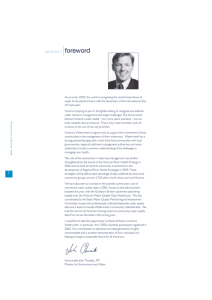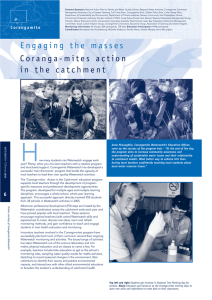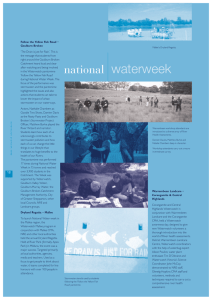! "##$
advertisement

! "##$ % & ! !"# $ % & # ' ( )* + ***************************************************************************************************************************************************************** , "* ,* .* ! ( &' '/ 0* ( ! & (& +! ******************************************************************************* . ******************************************************************************************************** 0 %*********************************************************************************************************************************** 0 ! &********************************************************************************************************************************************* 1 ! ******************************************************************************************************************************************************* 1 & & 4 )#* & ! & ********************************************************************************************** 1 + !****************************************************************************************************************************************************)# ))* ! ((- )" ! ),* ( ). )0* ! ( (& !***************************************************************************************************************************************************** 1 2* $* + - (& 1* 3* ************************************************************************************************** , ! & !4 !' !******************************************************************************************************)# ************************************************************************************************************************************************* )) *************************************************************************************************************************************). !! & 5 6 74 ********************************************************************************* "# 4 !***************************************************************************************************************************************************************** ", )1* (& ****************************************************************************************************************************** ", !********************************************************************************************************************************************* ". )2* % & )3* ( !************************************************************************************************************************************************************ ". 44 & !**************************************************************************************************************************************************************** "0 )* + ( ) # * % % # # + $ % # + * ( ) # $ , * * # % # , * - $ % # "* ( .&&'# / % # * 2 0 0 ( * 1 ) # ( ) 0 * 2 ( #" 3 4) # .'*' % / # $ 6 *5 $ '' * # % # . 9 % .7 8 % # # *: - 5 * * * * ! #/ #+ * * # 5 ! $* * 6 * $ * - .&&'# ; #3 * % #3 * * #, < # * ' * * * # # : % - 1 # % = , * ; ,* &' % 1 &! . # ( # - (& +! ; # ; # 4% ; 1 * ; ; 1 , * 2 2 2 = , , * > 4 , , # # • • 3 * (> ) % % • * * # + # 1 0 $ % $ • 6 $ 4 3 # # ? @ # • • % ? • 4% • > @ 5 $ > (> A> )# • , • , • 5 $% , > A> ; • B, B, % * (, .')# # % # .* '/ ! & , ! ( (& * $ $ # + "# 0 • * B , % # • $ # • • $ , ; 3 $ % • C 1 * # # • • • • , * * * , # + $ $ # $ * 0* (& % % ; .( ( 3 $ 3 ( % # , )* 3 ( A $ # '( )* 2 * A ) )# $ % 6 )# , # % * $* # , , * % % " # $ > A> # 1* ! % # 4 % A 6 # • • • • $ % % % $ D D D % # % ; # % 2* # ! & * ! B • • • • • • • E 4 =E = 1 C E C F 3 F E G,A ( )E A5 C/' /6 E H/ A5 A5 / E° % ( *% * ) # 3* # ! % .# % B+ ! * * A (.* * ' I ) 6 # # : "# 3 $- $ # $* + , & & 4 & / * ! & (,/ ) * 3 % # J * * * % # 8 $*) & ,/ % $ , 3 ( $)# , # B • 4% • 5 % % * % * # 5 # • , 5 $ % % # • $ , • K , % > > , # $ # 5 $ $ /6 # $# + $ # 3 $ 7 # ' ) ! !& + 4 1 , 4 1 , ' ; ± H ; ,A ±.H ; . G,A ( ! ,) #. ,A ( ! ,) ±.H #. E .&& G,A 4 , .. =, = #. ! # ,A ) . !C =!36, ,A . G,A !.&#& ,A 4 ( , ± H ! .&#& ,A ! = 8 ( ! ,) ; .# ! . # = #. = ± #. = ; .# ! . # = # . = ± # . = ; #" ! . # = #" = C ; C F ; L. ! ; C F 6 C F = = 19& ( ! 4 !. 3 F ; ± 3 F 0 ±.° ; ) !" ! " ° !, !" 1 3 F .° ° #.° ± #.° $ % % # ." ! #. A ; ( * # ."* # '* # "* # 8* # 9* #..* #. A5) C !C =4 # .! # " ; ( * # .* # * # '* # "* # 7* #. * C 9 ; + 1 1 #."* # * # " A5) A5 !C =4 ; 5 = 19& ( A5 ± H # E #9." A5 # A ± # # E #9." A5 ! C = 17 5 $ / A # A C A #. A/ ± # = = 17 !. / A #. A/ ± # ' !. / A !C 6C !" A5 % B ; (.* * '* * "* 8* 9* . *. A5 / ) ±½ ; ( * . * "* " * . * " *" A5 C/') C B = * B &87&..'& 7'" &" * 3 , ; E ! ." / > C B.' 0 0 19& , 0 A C = C * A5 = =4 ; ; ) = (C/' E C) C # . # " /6 ; ( * # "* #. * #."* # * #' * # * #8 * #9 * .# A5) # "!.# A5 . 51 = , * B * ' "''' & . 97 8 " & A/ A/ 0 0 , )#* + ! . 9 (.'. )# #, # 5 # A # * - # 1 = , * # # 6 ! # #0 , 0 , # # * 0 $ * * 1 1 5 $ # + 0 1* F1# * 0 1 . #+ # # 0 , , .'"# 3 * + +C 0 = " +C . # 2 # # M # * # , 4 C ( 0 2 ( 2 )N ))* ! ((- * )# " , 2 ""# ! & !4 !' ! 1 ' "9 ! !: &' ( )# + (( C 0 ,$ 1 . 3 ! 4 / • 1 • • • 4 • • • • > 1 - ( % ) % % 4 M # • • • % * % ( 6 A % ) > 3 , # / 3 4 ! #1 B • • • • • • • % M / 4 % 3 ; % 4 4 # 1 B • • • • • • • )" : : ! -% ( 3 ; ) % ! )"*) ( & ! & 3 ; ! * # M ! * # .. # 3 , # , * % # % , 3 ( % 1 3 $ + % 6 $ , # , # )"*" ( ; ! $ • • • 6 )# B * * + # #+ , , ' . # ! , ' % $ # ( 60) # * < * : # ! 4 2 # % ( ) 0 ( 6 # , 4 / )# % .# # $ B * * * 4 % 1 @ % # 3 # % $ % # $ # ?+ . O $ # 3 % % # & 6 > $ # % . * 6 # # $ 6 $ ( #+ # # ) * # 6 # # * * # # 6 # # = % # $ # + % # # * % % * % *% * # 3 & # 6 6 # + ' # # & 6 , , ' , ' 6 # ! # ! % # * ,+2C 5 * # .' ! " # 6 # > A> $ * 6 % * % 6 , # > ' # # > A> % # $" 1 #, * # * ! > A> ! ' 6 % > A> $ # # # % !! $ ( 60)# $ # % * - # * ( 6 )# # , % ),* # , # , *' # ( # % * ( % % &!. * , # + ; ; * 1 * ),*) * )* 'I # M A # '! ! 2 0 $ # * ( * % # 1 )# 3 #, * # . ),*" '! ; ! # $ ( / 4 1 / 4 )* )# ( * A * # 3 % * % * ( 1 6 ; % # > 3 ' (, $)# + ) $ $ $ # % # $ # # , . # > - #, ' > -# ),*, 1 ; & 0 $# * 6* # 6 # $ # 6 ! $ ! # % ! % * # * # # = # , 6 6 # 6 /K- /K- > - # # 'E= 1 # % M # ." # 5 , 5 ' ,9: & +( 41 O 4 1 !( =+2= ,/3 5/ ) . 8 4 (G,A ) 8 . 144K 4 41 4! / (H C ( / ( =( ,/3 41 O 4 5 K4 ) ( ) " '" . ) 4 (G,A ) #" & 4 41 / (H A5) A5) 1 C ( / ( =( / (H . 8 4 (G,A ) 8 . ( / ( =( . 8 '8 . A5) #" ) &#" 8 ( ) '" . ) . 8 4 (G,A ) . . (C F) ) C 5/ A5) (C F) 1+;41 =+2= ,/3 B A5) A5) #" ) & " ( ) ' . = 4C 34 / (H C ( / ( =( (C F) A5) A5) ) & "#" ( ) ' . (C F) .8 #" ,/3 ' E= 5 41 O 4 1 /C A 4 5 C / (H , 4 41 5 1 =+2= ,/3 5/ ) . 8 4 (G,A ) . . C ( / ( =( ,/3 41 O 4 ) ( ) #" &#" "#" ' . =+2= ,/3 5/ ) . 8 4 (G,A ) 7 . 1 +C A5) A5) 1 4 41 / (H C ( / ( =( A5) A5) ) ( ) (C F) (C F) .7 #" &#" 8 ' . ,/3 Figure 2- Data Acquisition Flow Chart: This diagram shows the process for credible data collection. The quality control process steps are illustrated and the actions required by monitors and Waterwatch personnel to meet those standards. Equipment prepared for data collection Site Assessment made by monitor Training Quality Assurance Program Site Description (site description sheet) Quality Control Program Maintenance maintenance log Monitoring Plan Calibration logs Monitor prepared for data collection Data Confidence Spreadsheet Results transferred to Watwerwatch Coordinator Data Management Habitat Survey (stream habitat record sheet) Biological Survey (aquatic invertebrate data sheet) Physical and Chemical Monitoring (physical and chemical tests record sheet) .9 Waterwatch personnel actions Monitor actions Dialogue between monitors and Water watch personnel Figure 3. Data Management Flow Chart: This diagram shows the process for credible data management . The quality control process steps are illustrated and the actions required by monitors and Waterwatch personnel to meet those standards Data Sheets Data Entry (Corangamite Waterwatch Database) Check equipment Data Confidence Spreadsheet Data Verifcation Apply flagging processes eg hard/soft limits, statistical tests Data confidence criteria achieved for Standard 3 and Standard 4 data collection Data inside limits Data Validation Data 'QA'ed Data available to Vic Data Warehouse Data flagged as unusual Check procedure and calibration steps Repeat monitoring Consultation with monitor Data 'OK'ed Data explanable Water Quality Report (annual) Waterwatch coordinator/faciltator actions No explanation Monitor actions Dialogue between monitors and Waterwatch personnel .& Data Users eg. monitors, local councils, CMA, env consultants ),*. + ( ( !! # 3 % # , ( ( , .' )# 3 , . ) % ' # M * # * 4 . # ). !! % 1 & 5 ).*) 6 % # ! 74 4 > A> 6 6 E1 D 6 6 > 1 # ! 4 4 $ 4 * = # 5 % ' # 6 6 # !4 ! 4 4 $ 4 * =* # % # 6 ! & ! 4 $ * 4 * =* % % * 6 # A $ - # > A> # # * > A> # # > A> # , * # * $ % # > A> ( ; , > A> ( # 3 H % # ! # " A5 # 8 A5 # % ' . 4 ' 6 4 ! )# ."# )# , * # !( 4 ! ! 4 !* ! ! &' 4 1 4 1 ; = 4 1 ( A5 ) ± #' E #" = ± #" = . H . H H H H > A> $ * ,/ # # + M # %& 4% % % , . , # : K , ' - 64# # " % - > A> * % % , # . # # + ' 0 6 4 !* + $ J ! 3 ! 4% (, $ (, .) 2 % .) = A )# (, (1 > A> ! $ , F 2 I ') (, , ') (, .* * ') 1 4% J ( ! ( , J F , > A> / F C % > A> $ "B 6 % ) (, ! , , ! 4% (, (, (, (, 4% (, I ') 1 (, I ') F , (, I ') *'I ) I ') , (, ) (, I ') I , !, ! I ') .) .* I ') ') I % ).*"+ 6 4 ; $ > A> $ ; * % # #1 ! # ! % 4 * =* % % > A> 6 4 * =* # ( M )# , * M ( # 4% % # ) % % ( ) % # , , )0* # 4 ! > 1 # % * * * > A> * # ! * > A> $ # # * % % ( )# * $ $# % : # + # * $ % # * % ( 6 ) # / % )1* # (& $ #, % # # * , $ > A> % , , # % $ ( ) # ' 'I )2* % & ! " , B, ) )3* ( , , J M / 2 )# (0 ( ! 3 * ? @4 ? @3 ; " * * * ( ") # 44 & ! " Appendix A: Corangamite Data Confidence Framework: Regional adaptation of the Waterwatch Victoria Data Confidence Framework - Standard 1 Education Parameters Recommended Equipment Standard Methods Competencies Equipment type Electrical Conductivity pH Turbidity Temperature Reactive Phosphorous Dissolved Oxygen TDScan4 or pH strips Turbidity Tube (tube NTUs) Thermometer Merck Aquaquant Phosphorus test or La Motte DO test kit ECScan high Macherey-Nagel Visocolor HE Phosphate test Calibration methods One point calibration (2000µ S/cm) No calibration required No calibration required No calibration required Not applicable No calibration required Sampling and measurement methods Refer to Corangamite Waterwatch Field Manual: sampling page 10 measurement page 22 Refer to Corangamite Waterwatch Field Manual: sampling page 10 measurement page 18 Refer to Corangamite Waterwatch Field Manual: sampling page 10 measurement page 24 Refer to Corangamite Waterwatch Field Manual: sampling page 10 measurement page 12 Refer to Corangamite Waterwatch Field Manual: sampling page 10 measurement page 20 Refer to Corangamite Waterwatch Field Manual: sampling page 10 measurement page 14 Quality Control mechanisms Not applicable Record Keeping Instrument allocation log Waterwatch monitor competencies Group leader is shown best practice for each parameter prior to water quality testing activity (refer to Corangamite Waterwatch field manual ) Field and chemical safety Sample collection Waterwatch coordinator competencies Thorough use and application of statewide standard procedures and regionally specific procedures (refer to Corangamite Waterwatch field manual). Participation in statewide QAQC program. Participation in phys/chem training and refresher courses Quality Control Review Not applicable State-wide Quality Control review Not applicable Monitoring Frequency Physicalchemical parameters Random Database Data storage facility Corangamite Waterwatch Database Data validation Data entered onto database by coordinator or trained Waterwatchers only. Data entered onto database is checked against datasheets for correct transfer. Data not tagged as QA’ed on Corangamite Waterwatch Database. Datasheets are clearly marked once data is entered onto data base. Appendix A cont’d: Corangamite Data Confidence Framework: Regional adaptation of the Waterwatch Victoria Data Confidence Framework – Standard 2 Education & Data Collation Parameters Recommended Equipment Standard Methods Equipment type Calibration methods Electrical Conductivity pH Turbidity Temperature Reactive Phosphorous Dissolved Oxygen TDScan4 or pH strips Turbidity Tube (tube NTUs) Thermometer La Motte DO test kit ECScan high pHScan2 Merck Aquaquant Phosphorus test or One point calibration (2000µS/cm) Strips: no calibration required Macherey-Nagel Visocolor HE Phosphate test Not Applicable Check against precision thermometer Not applicable See instrument instructions Refer to Corangamite Waterwatch Field Manual: sampling page 10 measurement page 24 Refer to Corangamite Waterwatch Field Manual: sampling page 10 measurement page 12 Refer to Corangamite Waterwatch Field Manual: sampling page 10 measurement page 20 Refer to Corangamite Waterwatch Field Manual: sampling page 10 measurement page 14 pHScan2: two-point calibration (pH4 & pH 7 or pH7 & pH10 span appropriate for infield pH conditions) Competencies Sampling and measurement methods Refer to Corangamite Waterwatch Field Manual: sampling page 10 measurement page 22 Refer to Corangamite Waterwatch Field Manual: sampling page 10 measurement page 17 Quality Control mechanisms Refer to Corangamite Waterwatch Field Manual: page 25 Record Keeping Instrument specification log; Record of Calibration; Maintenance log; Monitor training log; Reagents Log Waterwatch monitor competencies Demonstrated ability for sample collection and testing procedure as directed in Corangamite Waterwatch field manual Maintenance log; Monitor training log; Maintenance log; Monitor training log; Reagents Log Participation in annual training/refresher session. Recording data; field and chemical safety Waterwatch coordinator competencies Thorough use and application of statewide standard procedures and regionally specific procedures (refer to Corangamite Waterwatch field manual). Participation in statewide QAQC program. Participation in phys/chem training and refresher courses Regional Quality Control Review Optional participation in regional mystery sample program.. State-wide Quality Control review Not applicable Monitoring Frequency Physicalchemical parameters Not applicable One a year - Quarterly 7 Optional participation in regional mystery sample program. Not applicable Database Data storage facility Corangamite Waterwatch database Data validation Data entered onto database by coordinator or trained Waterwatchers only. Data entered onto database is checked against datasheets for correct transfer. Data not tagged as QA’ed in Corangamite Waterwatch Database. Datasheets are clearly marked once data is entered onto data base. Appendix A cont’d: Corangamite Data Confidence Framework: Regional adaptation of the Waterwatch Victoria Data Confidence Framework – Standard 3 Data Collation & Education Parameters Recommended Equipment Equipment type Electrical Conductivity pH Turbidity Temperature Reactive Phosphorus Dissolved Oxygen TDScan 3 (for sample <2000µS/cm), pHScan2 Turbidity Tube (tube NTUs), Thermometer Merck Aquaquant P test La Motte DO test kit Macherey-Nagel Visocolor HE Phosphate test *Hach DR700 **Hach DR 890 (FAUs) TDScan4 or ECScan high (for sample >2000µS/cm) Standard Methods Calibration methods Sampling and measurement methods *Hach DR700, **Hach DR890 One point calibration is appropriate to these instruments (1413µS/cm or 2000µS/cm respectively) Two-point calibration Tube: no calibration (pH7 & pH10) before all sampling DR890: by manufacturer Refer to Corangamite Waterwatch Field Manual: sampling page 10 measurement page 22 Refer to Corangamite Waterwatch Field Manual: sampling page 10 measurement page 17 Refer to Corangamite Waterwatch Field Manual: sampling page 10 measurement page 24 Check against precision thermometer (in solution) Colorimeter calibration curves with know standards **Hach DR890 La Motte DO test kit: reagents replaced biannually with fresh reagents HACH colorimeters: See instrument instructions **HACH DR/890 Data logging Colorimeter Handbook p511 Quality Control mechanisms Refer to Corangamite Waterwatch Field Manual: page 25 Record Keeping Instrument specification log; Calibration log; Maintenance log; Training log; Reagent Log 9 Refer to Corangamite Waterwatch Field Manual: sampling page 10 measurement page 12 Refer to Corangamite Waterwatch Field Manual: sampling page 10 measurement page 20 Refer to Corangamite Waterwatch Field Manual: sampling page 10 measurement page 14 *HACH DR/700 Colorimeter Manual module 81 p47 *HACH DR/700 Colorimeter Manual module 52 p97 **HACH DR/890 Data logging Colorimeter Handbook p407 **HACH DR/890 Data logging Colorimeter Handbook p369 Competencies Waterwatch monitor competencies Demonstrated sample collection and testing procedure as directed in Corangamite Waterwatch field manual Participation in training/refresher sessions. Logging calibration records. Recording data; field and chemical safety. Participation in regional QA/QC program. Waterwatch coordinator competencies Thorough use and application of statewide standard procedures and regionally specific procedures (refer to Corangamite Waterwatch field manual). Participation in statewide QA/QC program. Participation in phys/chem training and refresher courses Regional Quality Control Review Participation in regional QA/QC program (twice/year). Acceptable limits ±10% EC Participation in regional QA/QC program (twice/year. Acceptable limits ± 0.3 pH units State-wide Quality Control review Yearly review of regional implementation of DCP. Participation in regional refresher sessions and QA/QC program. Shadow test against other parties Participation in regional refresher sessions and QA/QC program. Shadow test against other parties Participation in regional QA/QC program (twice/year). Acceptable limits ±20% actual mg/L value Participation in regional refresher sessions and QA/QC program. Shadow test known sample against other parties. Participation in statewide QA/QC encouraged (but not mandatory) Monitoring Frequency Physicalchemical parameters Monthly - Quarterly Database Data storage facility Regional Waterwatch database; DSE Data Warehouse Data validation Data entered onto database by coordinator or trained Waterwatchers only. Data entered onto database is checked against datasheets for correct transfer, or checked with monitors if considered an anomaly. Data tagged as QA’ed on Corangamite Waterwatch Database. Datasheets are clearly marked once data is entered onto data base. Appendix A cont’d: Corangamite Data Confidence Framework: Regional adaptation of the Waterwatch Victoria Data Confidence Framework – Standard 4 Data Collation Parameters Recommended Equipment Equipment type Electrical Conductivity pH Turbidity* Temperature Reactive Phosphorus* Dissolved Oxygen* TDScan 3 (for sample <2000µS/cm), pHScan2 Hach DR 890 (FAUs) Thermometer Hach DR700 Hach DR700 Hach DR890 Hach DR890 Colorimeter calibration curves with know standards See instrument instructions TDScan4 or ECScan high (for sample >2000µS/cm) Standard Methods Calibration methods One point calibration is appropriate to these instruments (1413µS/cm or 2000µS/cm respectively) Two-point calibration (pH7 & pH10); Calibration before all sampling. DR890: by manufacturer & Check against precision thermometer (in solution) Competencies Sampling and measurement methods Refer to Corangamite Waterwatch Field Manual: sampling page 10 measurement page Refer to Corangamite Waterwatch Field Manual: sampling page 10 measurement page 17 Refer to Corangamite Waterwatch Field Manual: sampling page 10 Refer to Corangamite Waterwatch Field Manual: sampling page 10 measurement page 12 Refer to Corangamite Waterwatch Field Manual: sampling page 10 Quality Control mechanisms Refer to Corangamite Waterwatch Field Manual: page 25 Record Keeping Instrument specification log; Calibration log (EC and pH meters only); Maintenance log; Monitor training log; Coordinator training log Waterwatch monitor competencies Quaternary standard exclusive to Corangamite Waterwatch Coordinators where equipment is available. Waterwatch coordinator competencies Thorough use and application of statewide standard procedures and regionally specific procedures (refer to Corangamite Waterwatch field manual). Refer to Corangamite Waterwatch Field Manual: sampling page 10 Participation in statewide QAQC program. Participation in phys/chem training and refresher courses Regional Quality Control Review Regional mystery samples for volunteers to measure for core indicators (twice/year) Regional mystery samples for volunteers to measure for core indicators (twice/year) Regional mystery samples for volunteers to measure for core indicators (twice/year) Shadow testing in field against other water monitoring parties or check against precision thermometer (in water at 2 temperature points) Participation in regional mystery Regional mystery samples for sample program (2 times per volunteers to measure for core year) Groups encouraged to fall indicators (twice/year) consistently within acceptable limits State-wide Quality Control review State-wide mystery samples (June): Monitor expected to fall consistently with in acceptable limits (10% EC) State-wide mystery samples (June): Monitor expected to fall consistently with in acceptable limits (± 0.3 pH units) State-wide mystery samples (June): Monitor expected to fall consistently with in acceptable limits (± 20% NTUs) Shadow test against other parties or check against precision thermometer (in water at 2 temperature points). State-wide mystery samples (June): Monitor expected to fall consistently with in acceptable limits (± 20% mg/L P value). Shadow test against other parties. Monitor expected to fall consistently with in acceptable limits (± 20% mg/L) Yearly review of regional implementation of DCP Yearly review of regional implementation of DCP Yearly review of regional implementation of DCP Yearly review of regional implementation of DCP Yearly review of regional implementation of DCP Yearly review of regional implementation of DCP Monthly (min) Monthly (min) Monthly (min) Monthly (min) Monthly (min) Monitoring Frequency Physicalchemical parameters Monthly (min) Database Data storage facility Regional Waterwatch database; DSE Data Warehouse Data validation Data entered onto database by coordinator or trained Waterwatchers only. Data entered onto database is checked against datasheets for correct transfer, or checked with monitors if considered an anomaly. Data tagged as QA’ed in Corangamite Waterwatch Database. Datasheets are clearly marked once data is entered onto database. *Discussion with Sara Johnson in August 2004 that the requirements for these parameters are subject to change with the modified Waterwatch Victoria Data Confidence Guidelines ' Appendix B. Training checklists for “Coranga-mites”, Introductory, Refresher and Advanced components of the Waterwatch training process. Training Checklist – Coranga-mites Component An explanation of the information and procedures in the Coranga-mites – Action in the Catchment education manual and the Coranga-mites Field manual. P P P P The Corangamite Waterwatch program Corangamites- Action in the Catchment - overview Monthly Activities Rainwatch Habitat Survey P Define stream habitat zones Water Quality Monitoring Field Safety Chemical Safety Sample Collection, Preservation and Storage Sampling equipment and maintenance Testing order Procedure, calibration and maintenance for Temperature pH Phosphorous Conductivity Turbidity Interpreting Results Macro-invertebrate Sweep - sampling Equipment Data Management Complete Kit contents and Distribution Form '. P P P P P P P P P P P P P P P Training Checklist – Introductory/Refresher Component Information and procedures as stated in the Corangamite Waterwatch Field Manual – for secondary and tertiary standard data collection. The Corangamite Waterwatch program Complete General Information Form Complete/ Review Monitoring Plan (expectations and responsibilities) Establish standard of data to be collected Complete Site Description Sheet 1 P P P P P Habitat Survey P P Define stream habitat zones Complete Stream Habitat Record Sheet Field Safety Chemical Safety Sample Collection Sampling equipment and maintenance Sample Preservation and storage Testing order Procedure and calibration for: Temperature Dissolved Oxygen pH Phosphorous Conductivity Turbidity Record precalibration values for pH and EC meter (Standard 3 data collection only) Complete Physical and Chemical Tests Record Sheet Data Management ' P P P P P P P P P P P P P P P Training Checklist – Advanced Component Information and procedures as stated in the Corangamite Waterwatch Field Manual – for standard 2 and standard 3 data collection. Review the following: The Corangamite Waterwatch program General Information Form Monitoring Plan (expectations and responsibilities) Complete Site Description Sheet 1 (annual) Follow procedures in the Corangamite Waterwatch Field Manual for: Macro-invertebrates Field safety Equipment Kick Sampling Sweep Sampling Sorting and Identification SIGNAL scores – Complete Aquatic Invertebrate Data Sheet Quality Control Program Requirements Mystery samples Shadow samples Results Data Management '' P P P P Appendix C. The training form used to log Waterwatch training sessions and the activity form used to log community participation in Waterwatch events. Data collected is entered in the Watchman database. Training Form Training Facilitator:________________________________________________________________ Trainee:______________________________ Monitoring Group:____________________________ Date: ______________________Time: _____________________Duration:____________________ Training Type: (please circle) Coranga-mites Introductory Intro– Follow up Refresher Advanced Advanced (QAQC only) QC competencies met: Y/N Trainee data standard: primary secondary tertiary Training checklist completed: Y/N Activities Form Activity:___________________________________________________________________________ Facilitator:_________________________________________________________________________ Date:_______________________________Time Start:________________Finish:________________ Location:__________________________________________________________________________ School/Group:_____________________________________________________________________ Contact:_____________________________________Contact No.:___________________________ ' Appendix D. Field data sheet used to collect Standard 2 and 3 data '" Appendix E: Kit servicing procedure WATER MONITORING KIT SERVICING The Lamotte water quality kits used by both primary and landcare groups need to be regularly serviced to ensure probes, glassware, etc., are clean and results obtained are accurate. This guide will help you follow an easy procedure to cleaning all the equipment used. What the servicing kit should contain : • 1 litre bottle fresh conductivity standard • 100ml bottle 10% HCL • 100ml bottle 50% methylated spirits • Fresh pH 7 Buffer • Fresh pH 10 Buffer • 2 waste bottles • Safety gloves and glasses • 1 box of tissues • Normal saline eyewash ampules • 2 bottles of distilled water • Replacement Batteries • Two small beakers WARNING : Wear safety gloves and glasses when handling any of the above chemicals. All wastes should be disposed of into the wastes bottle and returned to the lab. All kits should be clearly labelled and contain field notes. MSDS (material safety data sheets) for all chemicals must be included 1. pH Meter The glass probe on the pH meter is very sensitive and needs to be thoroughly cleaned with acid and methylated spirits to remove any contaminants affecting the performance of this meter. Step 1. Place the probe in a beaker with enough 10% Hydrochloric acid (HCL) to cover the probe only, allow probe to soak in the acid for no longer than 1 minute. Rinse the probe thoroughly with tap water and wipe dry with a tissue. '8 Step 2. Place a few drops of methylated spirits on a tissue and gently wipe the glass probe clean, be careful not to touch the probe. Rinse the probe with distilled water and place probe in a fresh pH 7 and pH 10 Buffer to check calibration. * N.B. Replace the pH 7 and pH 10 Buffers with the new buffers supplied in the servicing kit. Check that batteries are OK, often the meter won't calibrate if batteries are on the way out. Check levels of Buffers and distilled water. Replenish if low. Remember to leave the pH meter soaking in the pH Buffer 7 when not in use (mention this to groups). 2. Phosphate Kit Contamination of the glass tubes within the phosphate kit may occur at any time. It is important that these glass tubes are soaked in acid to remove any phosphate that is bound to the glass. Step 1. Replace both glass tubes with tubes that have been cleaned at the cage in Decon 30 (5% solution). Step 2. Check chemical levels are OK. Replace P1 or P2 as necessary 3. Conductivity Meter The stainless steel electrodes need to be kept clean and free from dirt etc., to ensure accurate readings are obtained. Step 1. To a beaker add enough 50% methylated spirits to cover the electrodes only. Allow to stand for 15-20 minutes. Step 2. After elapsed time, pour into waste bottle and gently wipe the electrodes with a tissue then rinse with distilled water. * N.B. Replace the conductivity standard and check to see if the meter is correctly calibrated. Adjust as neccesary. Check batteries as well, if reading is faint, won't stabilize, disappears or won't calibrate, often batteries are the problem. 4. D.O. Kit The glassware used in D.O. determination also needs to be clean and free of contaminants. Step 1. Replace the sample bottle, titration container and syringe with appartus that ha been cleaned at the cage with Decon 30 (5% solution). Step 2. Chemical bottles should be replaced with bottles that have been filled in the cage to minimise handling risks. 5. Turbidity Tube, Thermometer These two items are easily cleaned. The thermometer should be checked for any cracks and glass should be clean to make readings easy. The turbidity tube should also be free from dirt both inside and out. Rinsing with tap water should remove all dirt from inside and wiping the outside of tube should clean the plastic. '7




